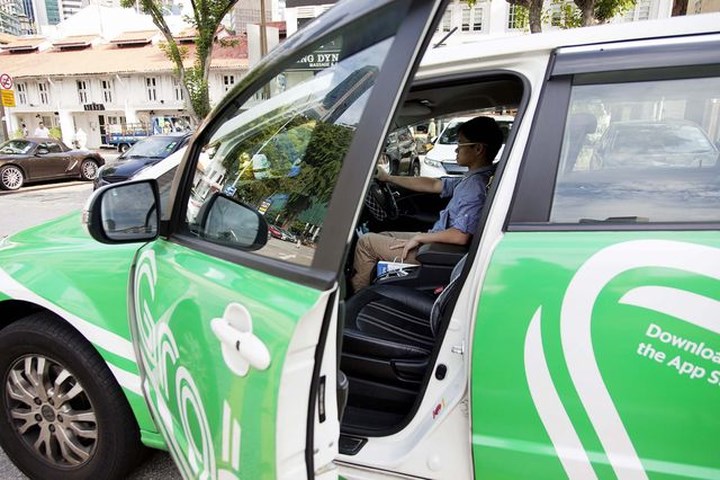GrabTaxi Vietnam will have to stop implementing its ride-hailing services at the three provinces of Thua Thien-Hue, Ba Ria-Vung Tau, and Lam Dong.

This was the order of Le Dinh Tho, Deputy Minister of Transport, after finding that GrabTaxi implemented the ride-hailing services in the provinces without a government permit for such contracts, based on Decision No.24/QD-BGTVT on the pilot scheme for ride-hailing services issued by the Ministry of Transport (MoT).
Besides, according to MoT, GrabTaxi is only permitted to directly work with taxi drivers to supply this service after receiving the approval of the transport business firms and the departments of Transport at the cities and provinces.
Earlier in December 2017, MoT reported to the prime minister about the implementation of the two-year pilot programme of ride-hailing services via technology applications. Accordingly, the authorities identified numerous violations in GrabTaxi and Uber’s operations. Notably, in a number of areas, GrabTaxi and Uber are implementing ride hailing services without reporting on their operations to local authorities or maintaining a representative office or legal representation.
Thus, in order to tightly supervise the operation of transport firms supplying technology applications of electronic matching, such as Uber and GrabTaxi, in early January 2018, MoT submitted the draft of a new circular that includes regulations for passenger transport (by car) through software.
Accordingly, technology application providers must meet ten conditions. Notably, technology application providers will have to have business licences or enterprise registration certificates to do electronic business and have a certificate from the Ministry of Industry and Trade (MoIT) confirming that applicants have completed registration.
Besides, before launching operations, technology application providers must register information related to their main offices and brands in Vietnam, their legal representative, transaction phone numbers, bank accounts, and websites, among others, with MoT.
Importantly, these firms must sign contracts to provide software services for transportation companies that hold transport licenses instead of providing them for individuals or transport business households.
These firms must display their logos with the minimum size of 90 x 80 mm in both the front and rear car windows.
Regarding tax payments, the circular clearly states that software providers and transport companies must provide all information related to trips and electronic bills to both the passengers’ accounts and the General Department of Taxation (GDT), under the regulation of the Ministry of Finance.
For enterprises who would like to use electronic bills, the circular stipulates 11 conditions. Important requirements include that enterprises must use software which has already been certified by MoIT, send electronic bills to GDT, and provide telephone numbers to customers for emergencies.
Cars under nine seats, which are used for electronically-billed transportation, must not be more than 12 years old, same as the regulation for traditional taxis.
According to the latest developments, Hanoi has put up traffic signs banning under nine-seat transportation cars using technology applications to match with customers from operating on roads that are off-limits to traditional taxis.
Accordingly, the ban is applied to streets like Giang Vo, Cat Linh, Phu Doan, and Truong Trinh.
Numerous Uber and Grab drivers expressed their concerns about the impact of this ban on their jobs. Son, an Uber taxi driver, said that he was surprises to see the ban signs in front of Viet Duc Hospital at Phu Doan Street, where he often drives passengers through.
Besides, Minh Duc, another Uber taxi driver with two years of experience in the job said that the ban will reduce the number of technology taxi drivers as Uber and Grabtaxi currently determine the shortest route for customers. Thus, if there is banned road along the predetermined route, drivers will have to choose another route without being paid for the added mileage in case the alternative route is longer.
"If a customer chooses the pick-up point on one of these roads, we would be unable to go there so we will have to cancel the trip. We would lose customers and have our stars and bonus points deducted," Duc stated.
Meanwhile, other technology taxi drivers wonder about the way management authorities determine the definition of technology taxi. They also wonder whether they would be fined if they drive their relatives through restricted roads.
A representative of the Hanoi Department of Transport told Vnexpress that the local authorities will issue plaques or other visible signs to distinguish technology taxies from individual cars. These signs will be published soon.
On January 7, 2016, MoT issued Decision No.24/QD-BGTVT on the pilot scheme for ride-hailing services. The pilot duration was two years, lasting from January 2016 to January 2018.
According to the decision, the pilot programme of ride-hailing services will be implemented in five cities and provinces, namely Hanoi, Quang Ninh, Danang, Khanh Hoa, and Ho Chi Minh City.
However, after two years, only four cities and provinces have joined the programme, while Danang remained exempt.
Of the 36,800 registered vehicles, there are 21,600 in Ho Chi Minh City, 15,000 in Hanoi, 62 in Quang Ninh, and 100 in Khanh Hoa.
In Ho Chi Minh City alone, GrabTaxi has more than 18,100 vehicles and Uber over 3,600 vehicles. The respective numbers in Hanoi are some 11,400 and nearly 2,400.
Nhan Dan